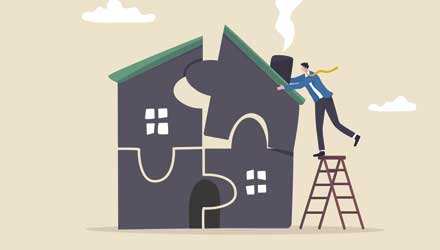By Sophie Neaves on Mon 19 February 2024 in Blog
Deconstructing the Social Housing (Regulation) Act
The Social Housing (Regulation) Act helps ensure tenants get the safe, warm and decent homes they deserve. It provides new enforcement powers to tackle failing and hazardous social housing, so landlords address damp, cold and unsafe conditions in their properties swiftly. Not only does it cover the safety and quality of social housing, but how tenants are treated by their landlords.
Read on to discover more about what the Social House (Regulation) Act includes, and what you need to know as a landlord or developer.

What is the Social Housing (Regulation) Act?
The Social Housing (Regulation) Act 2023 outlines how social housing is managed. Its aim is to bring about significant improvement to the social rented sector and increase the regulation of social landlords with new rules that protect tenants from serious hazards.
Following the Grenfell fire tragedy in 2017, a review of the adequacy of social housing was set out. Subsequently, the government published the Social Housing White Paper in 2020 and more recently Awaab Ishak’s death and the Housing ombudsman’s finding of severe maladministration have paved the way for The Social Housing (Regulation) Act 2023.
As a landlord, it’s important to understand what the Act includes so you can responsibly make any improvements or changes necessary to comply with it. Having a proper ventilation system in place, for example, is a solution to damp and mould issues, avoids hazardous living conditions for tenants, and has serious legal consequences for you.
Social housing regulation 2023 - what are the changes?
On 20 July 2023, the Social Housing Regulation Act became law in the UK to improve the quality of life for those living in social housing across the country, with changes expected to take effect in 2024.
As was first proposed by the government in 2018, the Act reintroduces proactive regulation and removes the ‘serious detriment test’, which previously limited intervention for those at risk.
The Act includes key changes such as:
-
Strict time limits for social landlords to address hazards such as damp and mould
-
The Regulator of Social Housing (RSH) can carry out regular inspections and is given the power to issue unlimited fines to social landlords.
-
Regulators will have greater authority to enter properties within 48 hours and make emergency repairs where there is a serious risk to tenants.
-
Requirement for landlords of social housing to have a health and safety lead.
-
Duty of the landlord to offer alternative accommodation to tenants whose safety is threatened, on equivalent terms to their existing tenancy.
-
A new ‘Access to Information’ scheme for tenants.
-
Additional Housing Ombudsman powers, to provide best practice guidelines to landlords following investigations into complaints by tenants.
-
New qualification requirements for social housing managers.
-
Stronger economic powers to follow inappropriate money transactions outside of the sector
What are the regulatory standards in social housing?
Currently, in England, there are regulatory standards for social housing landlords to comply with. This is made up of regulatory requirements, codes of practice and regulatory guidance. These are the standards the Regulator of Social Housing follows. These split into economic and consumer objectives.
Economic standards
Economic standards do not apply to local authorities. The economic objective is to make sure landlords are well-managed and financially stable.
The three economic standards are:
-
Governance and financial viability standard
-
Value for money standard
-
Rent standard
Consumer standards
The consumer objective is to make sure tenants get quality accommodation, have choice and protection, and can hold their landlords to account. These consumer standards contain specific expectations landlords must comply with, and the outcomes they’re expected to achieve. The current role is reactive in response to referrals, and the regulator will only intervene when failure to meet the standards has caused or could cause serious harm. These apply to all registered providers including local authorities.
-
Home Standard
-
Tenancy Standard
-
Neighbourhood and community standard
-
Tenant involvement and empowerment standard
-
Tenant satisfaction measure standard
There will be new consumer standards to support the Regulator’s proactive role from April 2024. For local authorities, there will be a new regime for regular inspections and the new consumer standards will look at a variety of issues from health and safety, to landlord transparency, and housing management staff qualifications.
Awaab’s Law
Awaab’s law is legislation following the loss of two-year-old Awaab Ishak as a result of the extensive mould in his Rochdale home. This law aims to protect others from serious hazards in their homes. The Act sets out new requirements for landlords to address hazards such as dampness and mould within a fixed period.
Consultation is expected to take place on these requirements and once in force, a tenant could claim for breach of covenant if their landlord fails to comply.
Energy Efficiency and the Social Housing (Regulation) Act?
The act was amended during its passage through Parliament to include an additional objective for the RSH to ensure that homes are energy efficient.
More information will follow, but this gives a clear indication of the importance of prioritising energy efficiency in your properties, something that Airflow’s solutions can assist with, alongside ventilation.
What about the enforcement of the Social Housing (Regulation) Act?
There are increased enforcement powers that come with the Social Housing (Regulation) Act, these include:
-
The RSH to take surveys on properties directly (including obtaining warrants to access properties and take emergency repairs where there is serious risk).
-
Unlimited fines to landlords for non-compliance .
-
Performance Improvement Plans or ‘PIPs’ for landlords related to breaches of the consumer and economic standards, or failure to comply with transparency requirements.
-
Tenants can request information on landlords and copies of PIPs, with compensation payable to those tenants who are affected as a result .
-
Adjustments to the grounds to hold an inquiry.
-
The Housing Ombudsman (HO) has the power to ask landlords to measure their service against HO guidance on issues like damp and mould.
-
Removal of the ‘serious detriment’ test from the consumer standards for social homes so action can be taken proactively.
What do the Social Housing Act changes mean for landlords?
There’s no doubt that the Act is one of the most important pieces of legislation for landlords in many years. So now you’re clued up on what the Act includes, it’s time to make proactive changes to your properties where required to ensure you are compliant. Practical changes will start to be enforced in 2024, so now is the time to take action.
How Airflow can help
Take a look at the quality and standards of your properties, could there be any health and safety issues? If there are any condensation, ventilation or damp problems, consider how the installation of a proper ventilation solution could help. You can improve the air quality for tenants and avoid pollutant, damp and mould issues to meet regulatory standards with our trusted solutions. Take a look at our product range, or get in touch with our experts and we can help you find what you need.


